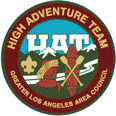 |
GLAAC-HAT High Adventure Awards Program |
 |
| Home | Calendar | Training | Awards * | Store | Publications | Flyers | Links | Contact Us | |||||||||
 |
GLAAC-HAT High Adventure Awards Program |
 |
| Home | Calendar | Training | Awards * | Store | Publications | Flyers | Links | Contact Us | |||||||||
Extracted from Hike Aid 6, dated February 2025.
Note: In the event of a conflict between this web page and the Hike Aid, the Hike Aid takes precedence.
| Table of Contents |
|---|
High Adventure awards are sponsored by the Greater Los Angeles Area Council of Scouting America, through the High Adventure Team (GLAAC-HAT), to stimulate interest and participation in a variety of outdoor activities and to recognize individual and Unit accomplishments. The awards program is an important feature of Scouting, continuing a practice begun by Lord Baden-Powell, that was based upon his experiences in the British Army. The "brag rag", upon which these awards may be displayed, is aptly named, and everyone deserves no less or more than they have earned by participating in your Unit's High Adventure Program.
The pursuit of these awards, however, must not become an end in itself. Their purpose is to expand and enhance the Unit's Scouting program. Developing Scouting, Venturing, and outdoor skills, promoting environmental awareness, and providing meaningful and enjoyable experiences for each participant are primary. The Unit Leadership should plan its High Adventure Program to achieve these objectives, as compatible with the abilities and interests of all of its members. The awards will follow, many of them and of great variety. The GLAAC-HAT, on its own, sponsors over 40 different, on-going High Adventure awards. The total number sponsored by the Councils in Southern California and adjacent areas are at least five times that. Practically all of them are available for members of your Unit to earn. Some of them may be earned several times.
This Hike Aid brings into a single document all of the information that the Unit Leadership needs to know about the GLAAC-HAT High Adventure Awards Program. Besides identifying the awards and their requirements, it covers how to get them, recordkeeping, displaying them, etc. Also included is a brief discussion of the awards programs of other local Councils. GLAAC-HAT Hike Aid 15, "Long-Term Trekking", and Hike Aid 16, "Peak Bagging: Program and Awards" contain additional information about the awards that are specific to those activities.
The GLAAC-HAT sponsors High Adventure awards to promote a diversity of outdoor activities in Southern California and its surrounding deserts and mountain ranges. The awards are categorized as backpacking, peak bagging, conservation, climbing, and special recognition. All of those discussed in this Hike Aid are on-going. The GLAAC-HAT occasionally sponsors one-time awards to recognize special events or activities.
Awards in the backpacking category are earned for a trip as short as five miles, with one night of camping, and as long as 50+ miles and a week or more duration. Their purpose is to encourage the Unit to build its backpacking program to meet the challenges of year-round, longterm, and diversity. Several different awards may apply to some backpack trips; however, each participant may receive only one, whether it is sponsored by the GLAAC-HAT or by another Council. The participants on a given trip don't all have to be given the same award, it's just that each is to receive only one. The GLAAC-HAT currently sponsors 15 backpacking awards, one having two segments and another having six.
The GLAAC-HAT initiated an award for climbing in the summer of 2005. The award is in recognition of the interest in technical climbing and is to encourage it beyond the basic merit badge. All such activity must be in compliance with Climb On Safely.
The Peak Bagger and Mini-Peak Bagger award programs recognize peak climbing in a variety of locations and conditions. Participants in this activity experience the challenge and the exhilaration of reaching the summit. Peaks may be climbed as a day hike, or as part of a backpack trip of any duration. Peak climbing credit toward these awards is in addition to, and independent of, an award for the backpack trip. The awards in these two series are for a cumulative number of peak climbs from specified lists. All peaks may be climbed without the use of technical climbing equipment and do not fall under the National Council program, Climb On Safely. Eight patches are available to be earned.
The conservation award program is, in part, the product of the 50 year collaboration between the GLAAC-HAT and the USDA Forest Service. There are two award series, TrailSaver and ForestSaver, each with four patches and a medal, which are earned on a cumulative hour basis. There are also two special conservation awards.
The special recognition awards sponsored by the GLAAC-HAT are for outstanding individual and Unit High Adventure achievement. There are currently six such awards: Backpacker, Advanced Backpacker, Silver Moccasins Medal, Master TrailBuilder, Lyle N. Whited Hiking Award, and Jim Hawkins Mountaineering Award.
One-time awards are sponsored to recognize participation in a unique activity or occurrence. They are announced through a special Program Announcement and in The Trail Head. The announcement will cover the reason for the award being offered, the requirements to be met, the duration for which it will be offered, and how to obtain the award. In recent years, the GLAAC-HAT has sponsored one-time High Adventure awards in recognition of the Mt. Baden-Powell Trail Restoration Program (1991-1993), the Silver Moccasins fiftieth anniversary (1997-1998), and the one-hundredth anniversary of the founding of the Boy Scouts of America (2007-2014).
All of the requirements for an GLAAC-HAT sponsored High Adventure award are to be met before the award may be presented. That this basic rule is followed is a matter of trust and of the integrity of the Unit Leadership.
Each award has a set of General Requirements that apply to it. Satisfying them should become a matter of routine to your outdoor program. As you read them, you will find that their underlying purpose is to promote a safe and enjoyable High Adventure experience. These General Requirements must be fulfilled by the Unit Leadership for its members to qualify for any High Adventure award sponsored by the GLAAC-HAT and by most other local Councils. Each award also has one or more Specific Requirements. They differentiate the awards and provide the special challenges. All awards that are sponsored by the GLAAC-HAT may be earned by all Scouts and Scouters, subject to their Council's HAT.
GLAAC-HAT sponsored awards are given only for participation in Unit or District/Council contingent sponsored activities, to persons who are registered with Scouting America at the time of the activity. Activities undertaken on a personal basis or before or after the person's registration with Scouting America do not qualify towards earning GLAAC-HAT sponsored High Adventure awards. The reason for this is fundamental to the purpose of having these awards - to encourage participation as a Unit, in Unit-sponsored High Adventure activities. The individual who is to receive the award is to have satisfied the General and Specific Requirements for it. It is strongly recommended that all adults hold current ARC Community First Aid and CPR Certifications or equivalent, and have had a full physical examination within the current year (Annual Health and Medical Record. Note: Part C of the medical record is required for events lasting longer than 72 hours.)
Note: In 2015 the Los Angeles Area Council (LAAC) and San Gabriel Valley Council merged into the Greater Los Angeles Area Council (GLAAC). All work done towards High Adventure Awards from either Council prior to this merger can be used towards GLAAC-HAT awards.
Each of the on-going awards sponsored by the GLAAC-HAT is listed on the following pages, and its specific requirements are discussed. The awards are grouped within the categories previously described.
The GLAAC-HAT Hike Aid 4, "High Adventure Procedures and Guidelines" presents the fundamentals of a High Adventure program. Being familiar with its contents is a necessary step in becoming trained as a leader of backpacking trips. Among other topics, the several forms and planning processes identified as required for earning many of these awards are discussed in detail in this brochure.
Unit leadership should plan and conduct its backpacking program through the use of Trail Camps and "dispersed site" camping opportunities, rather than the use of campgrounds, i.e. drive-in campsites. Besides the less than wilderness experience that campgrounds provide, most of those in the local mountains are very crowded on weekends, restrict the number of persons in a campsite, and charge a camping fee. Trail Camps and dispersed sites, while sometimes crowded, promote High Adventure and the development of Scouting and outdoor skills. Strict observation of "The Outdoor Code" and Leave No Trace are mandatory in those locations.
All applications for a backpacking award with a requirement of four or more days must be reviewed in advance by an authorized member of the GLAAC-HAT. A Unit in another Council that desires such an award may seek this review from its Council's HAT or GLAAC-HAT. If the Council has no HAT, GLAAC-HAT review is to be obtained.
These General Backpacking Requirements must be fulfilled by the Unit Leadership for its members to qualify for any High Adventure backpacking award sponsored by the GLAAC- HAT.
Scheduled backpack time is defined as "that time actually backpacking on the planned route with a full backpack." It does not include side trips, day hikes, fishing, etc. The general formula is two miles per hour of backpacking plus one hour for every 1,000 feet of elevation gain. For example: A 15-mile backpack equals 7-1/2 hours of scheduled backpack time. If the trek also climbed from 9,000 to 10,000 feet in elevation, an allowance of one hour would be added, making a total of 8-1/2 hours of schedule backpack time.
Each participant must satisfy all of the Specific Requirements for an award, as well as the Unit satisfying all of the previously mentioned General Requirements. It is strongly recommended that all adults who participate in High Adventure backpacking activities have completed Scouting America-conducted Adult Leaders Backpack Training.
Training Hike Award
Earn two of these Training Hike awards before earning any other hiking awards.
◊ Training Hike Award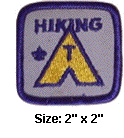
Weekend Awards
Certain awards have a specific requirement for the award recipient to have earned weekend awards. For this purpose, weekend awards are the National Forest, the National Park, and the California State Park awards. However, GLAAC-HAT sponsored awards which require more than seven scheduled hours and awards sponsored by other Councils which include a requirement of backpacking time of seven or more scheduled hours may be substituted.
◊ National Forest Award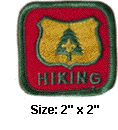
◊ National Park Award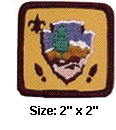
◊ California State Park Award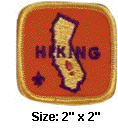
◊ Snow Hike Award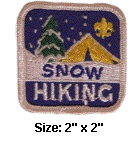
Longer-Term Awards
Award recipients to have previously earned two weekend awards within 90 days prior to the trek.
◊ Gabrielino Award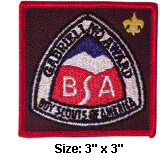
This award was designed for backpacking anywhere on the Gabrielino National Recreation Trail, that goes from Chantry Flats to Windsor Drive, Altadena.
◊ Golden Eaglet Mini-Long Term Award Pre-trip review required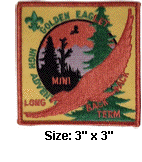
◊ Golden Bighorn High Adventure Backpack Award Pre-trip review required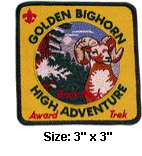
Take a backpack on the Santa Ana River Trail around Barton Flats, then back through the San Gorgonio Wilderness to Angeles Oaks.
Please refer to the GLAAC-HAT Hike Aid 15, "Long-Term Trekking", for additional information.
◊ High Adventure Backpack Award Pre-trip review required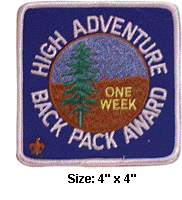
◊ John Muir Trail Award Pre-trip review required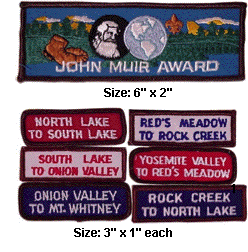
The following specific requirements apply for earning the primary patch and each of the Segments.
The John Muir Trail Patch is awarded only once, when the initial Segment is earned. Routes may be hiked in either direction and in any sequence. Please refer to GLAAC-HAT Hike Aid 15, "Long-Term Trekking", for additional information.
◊ High Sierra Trail Award Pre-trip review required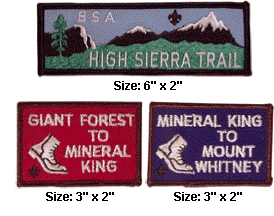
The following specific requirements apply for earning the primary patch and either Segment.
The High Sierra Patch is awarded only once, when the initial Segment is earned. Routes may be hiked in either direction and in any sequence. Please refer to the GLAAC-HAT Hike Aid 15, "Long-Term Trekking", for additional information.
Giant Forest to Mineral King Route
- Trailheads are at either Crescent Meadow or Wolverton and end at Mineral King.
- Six days, five nights minimum duration; one layover day in addition is recommended.
- Backpack time of 25 or more scheduled hours (usual route is 44 miles, with 7,500 foot elevation gain - 30 scheduled hours).
Mineral King to Mt. Whitney Route
- 1) Trailheads are at Mineral King and end at Whitney Portal, with an optional side trip to the summit of Mt. Whitney.
- Seven days, six nights minimum duration; one layover day in addition is recommended.
- Backpack time of 25 or more scheduled hours (usual route is 52 miles, with 12,000 foot elevation gain - 38 hours).
◊ Sierra North Award Pre-trip review required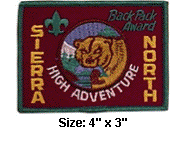
◊ Sierra South Award Award Pre-trip review required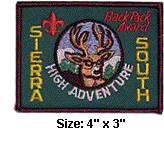
◊ Silver Moccasins Trail Award Pre-trip review required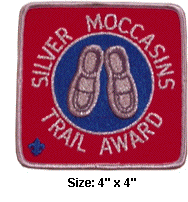
The following specific requirements apply, independent of the hiking route selected.
Angeles National Forest Route
- Must be taken on the Silver Moccasins Trail, Chantry Flat to Vincent Gap, in the Angeles National Forest.
- Six days, five nights minimum, of which one day is a mandatory layover day; one additional layover day is permitted.
- Backpack distance is 50 miles, with over 13,000 feet of elevation gain (40 scheduled hours).
- Menu accompanying the High Adventure Award Application must note the day(s) of a food drop.
- A maximum of two food drops are permitted, at the time and place of your choice.
In 2017, in an effort to save the mountain yellow-legged frog the Forest Service shut down the trail between the Burkhart Trail and Eagles Roost. A detour was created and is discussed in GLAAC-HAT Program Announcement 41, "Silver Moccasins Hike Detour". The Sequoia/Kings Canyon Routes
- Must be taken on a specified route in the Silliman Crest or Sugarloaf Valley areas of the Sequoia/Kings Canyon National Parks. See the GLAAC-HAT Hike Aid 15, "Long-Term Trekking", for the required routes.
- Five days, four nights minimum duration; one layover day in addition is recommended.
- Backpack time of 25 or more scheduled hours.
- Food drops are not permitted on these routes.
Please refer to GLAAC-HAT Hike Aid 15, "Long-Term Trekking", for additional information. The Silver Moccasins Medal is discussed In the Special Recognition section of this Hike Aid.
◊ Explorer Mountaineering One Week Backpack Award Pre-trip review required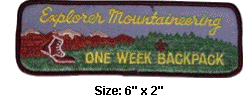
Units can choose their own route and location for their week long trek. Locations are generally above the 9,000' level and involve several thousand feet of elevation gain or loss per day.
This award is offered to stimulate the development of skills and in appreciation of climbing beyond those required to earn the Climbing merit badge. This award may be earned by Cub Scouts, Scouts BSA, and Venturers as noted.
| Please be advised that all climbing involves risks that the individual and his leaders assume when they participate in these activities. |
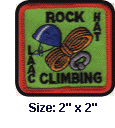 Plan and complete each outing in compliance with these National Council programs:
Plan and complete each outing in compliance with these National Council programs:
This is a concurrent award. Scouts BSA and Venturers may use climbs and rappels taken to earn Climbing merit badge to earn this award. The outings may apply to earning other outdoor awards.
A climb may be either a top-rope or a bouldering problem. Lead climbing is not allowed. A rappel is defined as a Scout moving down a stationary rope in full self-control. The person on rappel must be belayed either by a second rope or by a "fireman's belay". If the belayer is in control of the speed, the descent does not count as a rappel. A down-climb is similar to an up-climb, only the person is descending
To purchase this award prepare a High Adventure Award Application and send it, via email attachment, to: application@glaac-hat.org. List the names of the persons that have earned the award. Attach a note which shows the following for each outing taken to earn the award: date, location, names of Climbing Instructors, Climbing Directors, and Instructors-in-Training in attendance. Then go to our online store at https://glaac-hat.org/store/ and purchase the awards.
The two peak bagging award programs which are sponsored by the GLAAC-HAT are intended to encourage the Unit to extend the nature and range of its High Adventure program. Peak climbing credit towards earning them is additional to any backpacking award which may be earned on a given outing. In other words, you can do a weekend backpack on Mt. San Gorgonio, climb the summit, and, provided that they satisfy its specific requirements, give participants the National Forest award and peak climbing credit for the Peak Bagger award. A given peak may be climbed only once for credit for earning an award in either of these programs.
These General Peak Climbing Requirements apply to earning any peak climbing award sponsored by the GLAAC-HAT.
◊ Mini-Peak Bagger Awards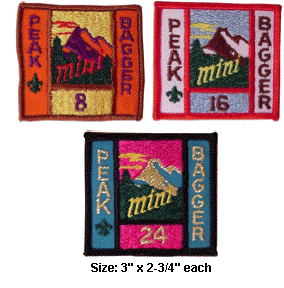
This award program is designed to introduce Units to backcountry peak climbing. Units can earn the awards in the Southern California mountain regions that are within easy reach for one-day outings. It is hoped that the Unit will see mini-peak climbing as an opportunity to supplement its weekend or short-term backpacking program. Approved peaks have elevations of between 5,000 to 10,000 feet and require minimal off-trail or cross country hiking.
A maximum of three peaks may be climbed for credit on a single outing; however, only two may be climbed on a single day. All eligible peaks are located in Southern California. An award is earned when 8, 16, and 24 (cumulative) different peaks from the approved list are climbed, and the other specific requirements are met. The following specific requirements apply to each award in this series:
| Note: | A Unit outside the Los Angeles area may make arrangements to do a project in the National Forest nearest its community. |
Please refer to the GLAAC-HAT Hike Aid 16, "Peak Bagging: Program and Awards", for additional information, a more complete discussion of these requirements, and a listing of the eligible peaks. The Mini-Peak Bagger Award Record is suggested for keeping track of individual participation and applying for an award.
◊ Peak Bagger Awards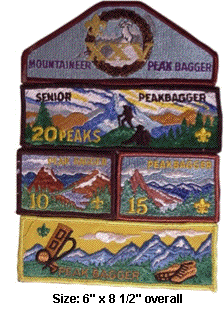
This award program is designed to stimulate a greater appreciation of the beauty, peace and majesty of the alpine wilderness. Each peak on the approved list has been carefully selected so that a variety of locations are reached, using backpacking rather than technical climbing skills. However, careful planning is still mandatory before climbing any of them. To quote from a Sierra Club film, "The mountain's don't care".
Your trip planning will normally provide for climbing one peak on a short term (less than five days) outing and two peaks on a long-term (five or more days) outing. Under certain circumstances, and in advance of the trip, the GLAAC-HAT does grant approval to climb an additional peak for credit on an outing. However, only one peak may be climbed in a single day. Most of the approved peaks are located in the Sierra Nevada and the San Bernardino Mountains. Most have an elevation of over 10,000 feet and each present a unique challenge.
An award is earned when 5, 10, 15, 20, and 25 (cumulative) different peaks from the approved list are climbed, and the other specific requirements are met. The following specific requirements apply to each award:
Please refer to the GLAAC-HAT Hike Aid 16, "Peak Bagging: Program and Awards", for additional information and a listing of the eligible peaks. The Peak Bagger Award Record is suggested to keep track of individual participation and for applying for an award.
These awards were developed by the GLAAC-HAT, in concert with the USDA-FS, to promote Unit participation in forest and trail conservation and construction projects. The initial award program, TrailSaver, was adopted in 1982 as a special activity to be offered for two years. It proved so successful that it was made permanent and has led to the adoption of a second award program, ForestSaver. All conservation work must have the prior approval by the GLAAC-HAT as to what, where, when, and how from the proper USDA-Forest Service representative, or administrator for a location other than a National Forest. All work must be done under the direction of a person, typically a Trail Boss, assigned by that representative. Units in other Councils may request other arrangements, depending upon their location.
Awards in these programs are earned when the participant performs 6,12,18, 24, and 30 hours of GLAAC-HAT approved conservation work.
Each conservation award earned may be used to qualify a person for at most one other GLAAC- HAT award. This restriction does not apply to concurrent awards such as the Lyle N. Whited Hiking Award, the Jim Hawkins Mountaineering Award, and the Jim Spencer Conservation Award.
Conservation hours performed to meet the requirements for another Council's conservation award may not be used to also qualify the person for a GLAAC-HAT conservation award.
Hours performed to meet the advancement requirements for Star, Life, and Eagle ranks may not be used to also qualify the person for a GLAAC-HAT conservation award, and vice versa. However, all other persons who work on an Eagle project may receive conservation award credit for the hours performed.
These General Conservation Requirements apply to earning any conservation award sponsored by the GLAAC-HAT.
◊ TrailSaver Awards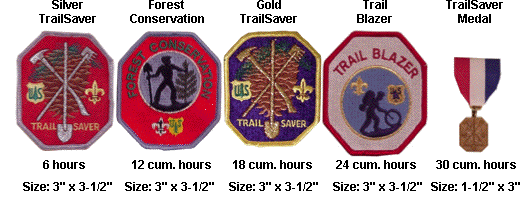
The TrailSaver program was developed in 1983, in coordination with Forest Service personnel in the Arroyo Seco District of the Angeles National Forest, to replace an awards program for trail conservation that had been in place for many years. This award program recognizes individual participation in trail construction and maintenance projects. This participation can be as part of a Unit service project or an Eagle project. The awards are earned in six hour increments, on a cumulative basis:
Please refer to the GLAAC-HAT Hike Aid 7, "Forest and Trail Conservation", for additional information about this program. The Conservation Award Log is used to obtain awards.
◊ ForestSaver Awards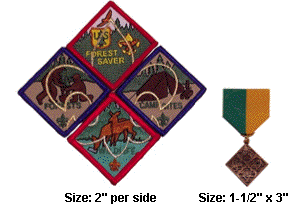
The ForestSaver program was developed in 1993 to recognize individual participation in forestry and associated construction and maintenance projects. This participation can be as part of a Unit service project or an Eagle project. There are three categories of projects:
◊ Campsite: campground or trail camp development, improvement, maintenance, and rehabilitation.
◊ Wildlife: habitat restoration, browse-way improvement, construction and maintenance of feeders and waterers, etc.
◊ Forestry: plantation clearing, tree planting, tree thinning and pruning, etc.
Awards are earned on the following basis:
◊ Campsite Award: six hours of effort in that category.
◊ Wildlife Award: six hours of effort in that category.
◊ Forestry Award: six hours of effort in that category.
◊ ForestSaver Award: earn the Campsite, Wildlife, and Forestry Awards and do an additional six hours of ForestSaver project work.
◊ ForestSaver Medal: earn the ForestSaver Award and do an additional six hours of ForestSaver project work.
The six hour projects for the ForestSaver Award and Medal may be in any of the three categories and may be performed at any time. Please refer to the GLAAC-HAT Hike Aid 7, "Forest and Trail Conservation"; for additional information about this program. The Conservation Award Log is used to obtain awards.
◊ Trail Boss Service Pin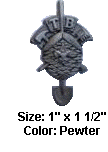
This award is given to Scouters by the Forest/Trail Conservation Committee of the GLAAC-HAT. Contact them to be considered for this award. It is earned when the Scouter accomplishes the following tasks:
◊ Jim Spencer Conservation Awards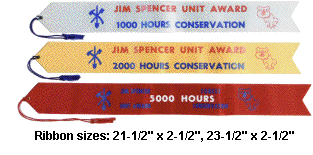
In the fall of 1991, the GLAAC-HAT announced the Jim Spencer Conservation Award to recognize the accomplishments of its long-time member, Jim Spencer. Jim worked with the U.S. Forest Service to develop and implement the Trail Boss training program which has subsequently spread nationwide. He was also instrumental in the creation of the GLAAC-HAT sponsored TrailSaver and ForestSaver Award programs.
This award, which honors his accomplishments, is a Unit award. It is earned when the following specific requirements are satisfied:
The award is a ribbon, to be displayed on the Unit's flag. A different colored ribbon recognizes each level - 1,000, 2,000, or 5,000 hours of conservation work. Contact the Chairperson of the GLAAC-HAT to obtain this award.
These awards are sponsored by the GLAAC to recognize the special accomplishments of an individual. They require participation in several activities, over a period of time.
◊ Backpacker Award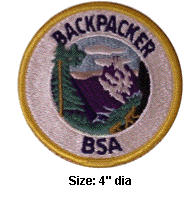
This award recognizes those persons who have earned a long-term backpacking award and have performed GLAAC-HAT approved conservation work in the same calendar year.
This award may be worn, as a temporary patch, on the Scout shirt. The Backpacker Award Application is to be used to obtain this award.
◊ Advanced Backpacker Award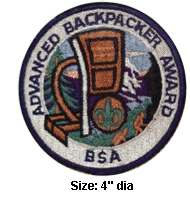
This award recognizes those persons who have participated in backpacking and conservation activities over an extended period of time.
This award may be worn as a temporary patch, on the Scout shirt. The Backpacker Award Application is to be used to obtain this award.
◊ Silver Moccasins Medal
This award challenges the backpacker to help construct and maintain the trails on which he/she hikes. It is a unique privilege to hang these Silver Moccasins, when attached to a leather thong, from the right pocket button of the Scout shirt.
◊ Master TrailBuilder Medal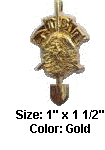
This award is presented to Scouters by the Forest/Trail Conservation Committee for continued service to the conservation programs of the USFS and the GLAAC-HAT. Contact them to be considered for this award.
It is not a matter of meeting a set of requirements, but of dedication to conservation. Jim Spencer was the initial recipient of this award, having set the standard for all of us.
◊ Lyle N. Whited Hiking Award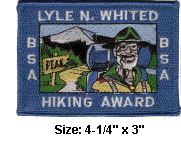
In September 1990, the Parents' Committee of Troop 211, Torrance, CA, decided to create a special award to recognize the diverse, year-round High Adventure program that the troop had experienced over the prior 20-plus years. As Lyle Whited had served as Assistant Scoutmaster/Hikemaster for over half that period, it also decided to put his name on it. For a number of years, this award was only offered to members of that Unit and of the local District. The GLAAC-HAT is now making it available to anyone who has met its requirements.
This special award may be earned concurrent with, and in addition to, any other High Adventure awards that were granted to satisfy the requirements listed above. The activity required may have occurred at any time while the recipient was affiliated with a Scouting organization.
The Lyle N. Whited Hiking Award Application is to be used to obtain this award.
◊ Jim Hawkins Mountaineering Award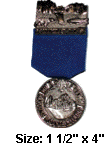
This award was developed by Troop 636, Rancho Santa Margarita, and honors Jim Hawkins, chairman of the Los Angeles Area Council High Adventure Team for over 40 years. The upper portion of the medal depicts Dusy Basin in King's Canyon National Park and three creatures that inhabit the Sierra High Country: Yellow-bellied Marmot, Clark's Nutcracker and Golden Trout. The lower portion shows 14,505-foot Mt. Whitney, the highest point in the contiguous 48 states.
| Mount Langley | 14,042' | Mount Whitney | 14,505' | ||
| Mount Muir | 14,015' | Mount Williamson | 14,375' | ||
| Mount Sill | 14,162' | Split Mountain | 14,058' | ||
| Mount Tyndall | 14,018' | ||||
| Notes: | 1) Peaks on the Peak Bagger list also count towards the Peak Bagger award. | |
| 2) If Mt. Whitney is climbed, the "14,505' Club" award may also be earned. |
| Reference: | Climbing California's Fourteeners, S. F. Porcella and C.M. Burns, The Mountaineers, Seattle, WA, 1999 |
The Jim Hawkins Mountaineering Award Application is to be used to obtain this award.
This special award may be earned concurrent with, and in addition to, any other High Adventure awards that were granted to satisfy the requirements listed above. The activity required may have occurred at any time while the recipient was affiliated with a Scouting organization.
A High Adventure award is earned when the recipient and Unit have satisfied all of its requirements, as presented in this Hike Aid and as supplemented in Hike Aid 15 and Hike Aid 16. However, the GLAAC-HAT will consider a request for a deviation to a requirement as a consequence of a special need or condition of the recipient or Unit. Such a request must be made in writing to the GLAAC-HAT, at least six weeks prior to the outdoor activity. The request must identify the award to be earned, the requirement for which a deviation is sought, and a detailed reason for requesting the deviation. The GLAAC-HAT will consider the request at its next scheduled meeting and respond in writing. No other organization or individual is authorized to change requirements for GLAAC-HAT awards.
A deviation may be for approval of a peak climb that is not on the Peak Bagger or Mini-Peak Bagger award lists, or an alternate approach to an approved peak. Such a request is to be made in the same manner as for any other deviation. Besides the name of the peak, the request must include its exact location, topographical map coverage, elevation, trailhead or route to be used in climbing, distance from the trailhead to the summit, and a comment about the general condition of the trail. This additional information is necessary to assess the suitability of the peak for qualifying and, if for the Peak Bagger award, to classify it. After the Unit completes this peak climb, it is requested that a detailed itinerary and appropriate recommendations be sent to the GLAAC-HAT to assist it in future evaluations of qualified peaks and routes.
When all of the requirements for a GLAAC-HAT sponsored High Adventure award have been completed, it may be obtained by preparing the appropriate application and getting any required approvals. All application forms can be found at the GLAAC-HAT web site.
Please send the application form(s), via email attachment, to: application@glaac-hat.org. The awards can then be purchased online at the GLAAC-HAT web site.
| Award | Required form(s) | Purchase |
|---|---|---|
| Backpacking | High Adventure Award Application, Trail Profile/Schedule |
Online |
| Mini-Peak Bagging | High Adventure Award Application, Mini-Peak Bagger Award Record |
Online |
| Peak Bagging | High Adventure Award Application, Peak Bagger Award Record |
Online |
| TrailSaver, ForestSaver |
Conservation Award Log, Participant Log |
Online |
| Trail Boss Service Pin, Master TrailBuilder |
Presented by the Forest/Trail Conservation Committee of the GLAAC-HAT, on the basis of its records of Trail Boss activity. Contact them to be considered for these awards. | |
| Jim Spencer Conservation Award | Contact the Chairperson of the GLAAC-HAT to obtain this award. | |
| Rock Climbing | High Adventure Award Application, See the award description for additional required information. |
Online |
| Backpacker, Advanced Backpacker |
Backpacker Award Application | Online |
| Silver Moccasins Medal | High Adventure Award Application, Conservation Award Log |
Online |
| Lyle N. Whited Hiking Award | High Adventure Award Application, Lyle N. Whited Hiking Award Application |
Online |
| Jim Hawkins Mountaineering | High Adventure Award Application, Jim Hawkins Mountaineering Award Application |
Online |
| One-time awards | One-time awards, by their nature, generally are obtained by using a separate process. See the announcement of the award for the required form and availability of the award. | |
A High Adventure patch is awarded to an individual to recognize his/her accomplishment. Giving out an award on any other basis cheapens it and demeans the accomplishments of those who have earned it. It is a matter of trust, the first Scout Law, and it is assumed that the Unit Leadership will follow this basic rule.
It is very easy to obtain any award, for any person. All that is needed is to prepare all of the required paperwork. The Unit members are normally the only ones who will know whether or not an outing was actually taken, a summit was actually reached, or an award recipient had actually met all of the requirements. High Adventure awards are never given or received on a complimentary or best-effort basis or as a consolation prize, they are earned by meeting all of the award requirements.
Therefore, it should be understood that these awards are not to be traded. The pride that goes with having earned them should keep most recipients from doing so. On the other hand, a patch not earned should have little interest to a Scout or Scouter who knows the meaning and value of earning it.
High Adventure awards are not a part of the Official Scout uniform. Because of this, they are not, with notable exceptions, worn on it, per National Council policy. The Silver Moccasins Medal, as a temporary patch, may be hung from the button for the right shirt pocket. The Backpacker or Advanced Backpacker award, as a temporary patch, and the TrailSaver Medal, and the ForestSaver Medals, sponsored by the GLAAC-HAT, may be worn on the Scout shirt. All other High Adventure awards of the GLAAC-HAT are to be displayed on a "brag rag", or in some other manner. Only one High Adventure award may be worn on the Scout shirt at any given time.
Patches are sometimes sewn to the backpack or pack cover. This has the disadvantage of degrading the waterproofing of these items. It also subjects the patches to dirt, moisture, abrasion, and possible loss. A "brag rag", which can be attached to a backpack or separately displayed on an appropriate occasion, is an excellent way to protect and show the awards.
As mentioned earlier, the other Councils of the Southern California and adjacent areas sponsor many, many High Adventure awards, to encourage backpacking, rafting, bicycling, soaring, peak climbing, conservation work, and other outdoor activities. Practically all of them may be earned by members of your Unit. These awards are recognized by the Greater Los Angeles Area Council and many may be purchased online at our web site store (https://glaac-hat.org/store/).
As with awards that are sponsored by the GLAAC-HAT, it is imperative that the Unit Leadership learn all of the requirements for the award and then satisfy them before applying for it. If the award is new to the Unit, it would be prudent to contact the sponsoring Council before the activity and request a copy of the current requirements and check on award availability. Some of these awards do not recognize 1,000 feet of elevation gain as an equivalent to two miles of backpacking, for example. There may be other differences in computing mileage, qualifying nights of camping, etc. All of these matters are at the discretion of the sponsor of the award.
Any deviation to a requirement for an award must be granted by the sponsoring Council. The GLAAC-HAT will only approve a request for a deviation for an award which it sponsors. Certain awards must be approved by, and obtained directly from, the sponsor Councils. The GLAAC-HAT can be of some assistance, but the Unit will have to deal directly with that Council to obtain one of these "controlled" awards.
To further its objective to promote a challenging outdoor program, the National Council sponsors several on-going awards and, periodically, limited-time ones. It establishes the requirements for earning and the method for obtaining them, often by the use of a special application form. See the National web site (https://www.scouting.org/) for details.
The GLAAC-HAT has no direct involvement with these awards and its approval is not required to earn them. It does, however, encourage Units to be aware of them and, particularly, to earn the unique limited-time ones. The rule that only one award may be earned for any outdoor activity applies also to some of these National Council awards. A Unit that earns one may not apply for any other award that is sponsored by the GLAAC-HAT, or any other local Council, for the same outing.
The 50-Miler Program has an award that may be earned for any 50 mile trek, including those taken at Philmont and Northern Tier, the High Adventure Bases. Neither the trek nor the conservation work requires GLAAC-HAT involvement or approval. However, it can help arrange for conservation work in the Angeles National Forest. This is a High Adventure award that a person should be proud to display.
The Historic Trails Program requires the Unit to research an historic trail or site, ideally through a local historical society. There are numerous such sites, and a few trails, throughout Southern California, although many may not be suitable for overnight camping. The basic purpose of the program, however, is not High Adventure but the performance of some activity to enhance the site or trail. A Unit that desires to earn the award should consider contacting an historical society and working with it to identify a site or trail and to conduct an activity that qualifies for it. The Mt. Lowe Tavern site and trail network qualifies and the GLAAC-HAT can arrange for a Unit to do conservation work in this area.
Hornaday Awards are granted to recognize exceptional and distinguished service in conservation by individuals and Units. These awards may be sought in addition to obtaining the applicable award(s) for the conservation project work, as offered by the GLAAC and other local Councils.
The National Outdoor Awards recognizes a Scout who demonstrates both knowledge and experience in one or more of six subject areas or segments: conservation, camping, hiking, aquatics, riding, and adventure. Once a segment is earned, Scouts can do additional work in that activity and earn special Scout program devices in gold or silver. National Outdoor awards may be earned concurrent with, and in addition to, any other High Adventure awards.
While never high on anyone's list of enjoyable activities, record keeping is a necessary and important part of a Unit's High Adventure program. It is desirable for each member of the Unit to keep his/her own records of participation in High Adventure activities and to advise the Unit Leadership of having satisfied the requirements for High Adventure awards and merit badges. However, it has been found that the most effective approach is for the Unit to have a centralized record keeping system. Such a system reduces the confusion and uncertainty about individual participation in activities and eligibility for awards, and ensures that all members are properly and promptly recognized for their High Adventure achievements.
Sample forms for recording participation in various types of outdoor activities are available on our web site at https://glaac-hat.org/ApplicationForms.html. Feel free to download them, if they meet your needs; or, amend them to better suit your Unit's program. The objective is to keep and maintain accurate records of these activities. These records are important to supporting your applications for High Adventure awards. You may want to clip a copy to the required form.
The members of the GLAAC-HAT are available to assist you in all matters regarding High Adventure activities. The easiest way to get in touch with the High Adventure Team is via the Contact Us page on our web site (https://glaac-hat.org/Contact.html). Questions in general, or about specific requirements for an award may be submitted there.
The GLAAC-HAT encourages your suggestions and comments about these awards, including proposals for new awards and for revisions to current awards. As stated at the beginning of this Hike Aid, the primary purpose of the High Adventure Awards Program is to stimulate interest and participation in a variety of High Adventure activities. You can help us make improvements to better achieve this goal.